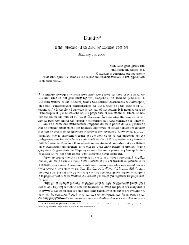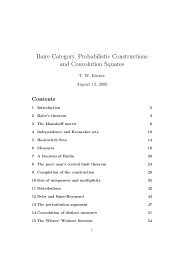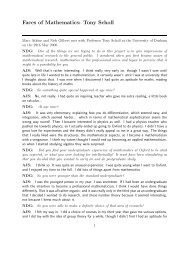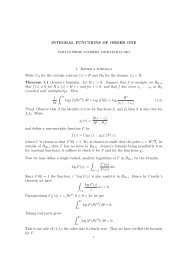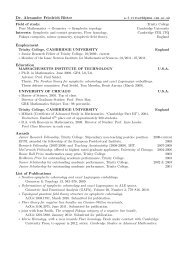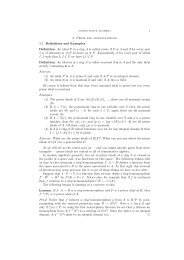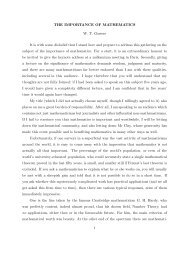THE SELBERG SIEVE, APPLIED TO TWIN PRIMES The theory of ...
THE SELBERG SIEVE, APPLIED TO TWIN PRIMES The theory of ...
THE SELBERG SIEVE, APPLIED TO TWIN PRIMES The theory of ...
Create successful ePaper yourself
Turn your PDF publications into a flip-book with our unique Google optimized e-Paper software.
<strong>THE</strong> <strong>SELBERG</strong> <strong>SIEVE</strong>, <strong>APPLIED</strong> <strong>TO</strong> <strong>TWIN</strong> <strong>PRIMES</strong><br />
PART III PRIME NUMBERS, MICHAELMAS 2004<br />
<strong>The</strong> <strong>theory</strong> <strong>of</strong> “small” sieves is large and rather bewildering for the beginner. In this<br />
chapter we present one example <strong>of</strong> a small sieve in action, using the so-called Selberg<br />
sieve to prove the following result:<br />
<strong>The</strong>orem 0.1. <strong>The</strong> number <strong>of</strong> twin primes less than N (that is, primes p such that<br />
p + 2 is also prime) is at most CN/ log 2 N.<br />
Remarks. Thus most primes are not twin primes. An amusing consequence <strong>of</strong> this<br />
result, which is <strong>of</strong>ten quoted, is that the sum <strong>of</strong> the reciprocals <strong>of</strong> the twin primes<br />
converges (to what is known as Brun’s constant). It is a famous unsolved problem to<br />
decide whether there are infinitely many twin primes.<br />
One <strong>of</strong> the biggest difficulties for the would-be sieve theorist is the bewildering array<br />
<strong>of</strong> notation in the subject. By studying one specific problem we can avoid a lot <strong>of</strong><br />
that, whilst hardly losing any <strong>of</strong> the ideas, but it would be remiss not to make some<br />
remarks relevant to the more general context. To place an upper bound on the number<br />
<strong>of</strong> twin primes less than N, one studies the sequence A = (an), where an = n(n + 2). If<br />
√ N � n � N and n is a twin prime, then an does not have any prime divisors smaller<br />
than √ N. Thus, for any z � √ N we have the upper bound<br />
number <strong>of</strong> twin primes p ∈ [ √ N, N] � |S(A, P, z)|,<br />
where S(A, P, z) is the collection <strong>of</strong> all a ∈ A which are not divisible by any p ∈ P with<br />
p � z. In our example we will take P = all primes, though there are problems where<br />
we might wish to use just a subset <strong>of</strong> the primes.<br />
What information do we know about A? Well, it is not very difficult to estimate the<br />
number <strong>of</strong> a ∈ A which are divisible by 2, 3, 4, . . . quite accurately. Write<br />
Ad := {a ∈ A : d|a}.<br />
<strong>The</strong>n |Ad| can be studied using the function ω, defined as follows. If p is prime, then<br />
ω(p) is the number <strong>of</strong> residues x(mod p) such that x(x + 2) ≡ 0(mod p). Thus ω(2) = 1<br />
and ω(p) = 2 for p � 3. Extend ω to a function on all <strong>of</strong> N by insisting that it be<br />
completely 1 multiplicative, that is to say ω(mm ′ ) = ω(m)ω(m ′ ) for all m, m ′ .<br />
As regards |Ad|, one easily sees that if d is squarefree then ω(d) is the number <strong>of</strong> solutions<br />
to x(x + 2) ≡ 0(mod d). Thus in this case (which will be the only one that interests us)<br />
where |Rd| � ω(d).<br />
|Ad| = ω(d)<br />
d N + Rd, (0.1)<br />
1 as opposed to just multiplicative, which means that ω(mm ′ ) = ω(m)ω(m ′ ) when (m, m ′ ) = 1<br />
1
2 PART III PRIME NUMBERS, MICHAELMAS 2004<br />
All <strong>of</strong> the above features are more-or-less typical in sieve <strong>theory</strong>. Once one has an<br />
understanding <strong>of</strong> Ad one might hope to estimate S(A, P, z) by using inclusion-exclusion:<br />
|S(A, P, z)| = N − �<br />
|Ap1| + �<br />
p1�z<br />
p1
<strong>THE</strong> <strong>SELBERG</strong> <strong>SIEVE</strong>, <strong>APPLIED</strong> <strong>TO</strong> <strong>TWIN</strong> <strong>PRIMES</strong> 3<br />
2. selberg’s observation<br />
Let λ : {1, . . . , z} → R be any function whatsoever with λ1 = 1. <strong>The</strong>n if a ∈ S(A, P, z),<br />
we have<br />
� � �2 λd � 1,<br />
d|a<br />
d�z<br />
since the sum collapses to just the one term with d = 1. It follows that<br />
|S(A, P, z)| � � � � �2 λd =<br />
� �<br />
λd1λd2 = �<br />
|A[d1,d2]|λd1λd2<br />
n�N<br />
d|an<br />
d�z<br />
d1,d2�z n�N<br />
d1,d2|n<br />
d1,d2�z<br />
Let us assume furthermore that λd = 0 if d is not squarefree. <strong>The</strong>n we may use (0.1) to<br />
write this in the form<br />
|S(A, P, z)| � N �<br />
d1,d2�z<br />
µ(di)�=0<br />
ω([d1, d2])<br />
[d1, d2] λd1λd2 + O( �<br />
d1,d2�z<br />
µ(di)=0<br />
ω([d1, d2])λd1λd2). (2.1)<br />
We have ω(d) = Oɛ(d ɛ ), since by multiplicativity ω(d) is no more than 2 ϖ(d) , where<br />
ϖ(d) is the number <strong>of</strong> prime factors <strong>of</strong> d (this is an exercise on the second example<br />
sheet – we also used it in [PN9]). It will turn out later on that whenever we apply (2.1)<br />
we will have the bound<br />
λd = Oɛ(d ɛ ) (2.2)<br />
In this case the error term in (2.1) is O(z 2 N ɛ ), which will be dominated by the main<br />
term if z = N 1/2−δ for some δ > 0.<br />
Write<br />
Q := �<br />
d1,d2�z<br />
µ(di)�=0<br />
ω([d1, d2])<br />
[d1, d2] λd1λd2<br />
for the main term in (2.1). Thus under the assumption (2.2) we have<br />
|S(A, P, z)| � NQ + Oɛ(z 2 N ɛ ). (2.3)<br />
Q is a quadratic form, and we wish to choose values <strong>of</strong> λd so that it is as small as<br />
possible. We do this by diagonalising the form. To begin with, we rewrite Q in the form<br />
Q = � ω(d1)ω(d2) (d1, d2)<br />
. (2.4)<br />
d1,d2�z<br />
µ(di)�=0<br />
d1d2<br />
λd1λd2<br />
ω((d1, d2))<br />
To get a handle on this, we use a fairly standard trick. Write g(k) = k/ω(k), and<br />
observe that by Möbius inversion we have<br />
g(k) = �<br />
f(δ)<br />
where<br />
f(k) = �<br />
δ|k<br />
δ|k<br />
µ( k<br />
δ )g(δ).
4 PART III PRIME NUMBERS, MICHAELMAS 2004<br />
Substituting into (2.4) and swapping the order <strong>of</strong> summation yields<br />
Q = �<br />
�<br />
�<br />
f(δ)<br />
ω(d)<br />
d λd<br />
�2 . (2.5)<br />
δ�z<br />
δ|d,d�z<br />
µ(d)�=0<br />
This is indeed a diagonal quadratic form, in the variables<br />
uδ := � ω(d)<br />
d λd.<br />
δ|d,d�z<br />
µ(d)�=0<br />
To minimise Q we need to express the constraint λ1 = 1 in terms <strong>of</strong> these new variables<br />
uδ. This can be achieved by applying Lemma 1.2. One obtains<br />
ω(d)<br />
d λd = �<br />
d|δ,δ�z<br />
µ(δ)�=0<br />
µ( δ<br />
d )uδ, (2.6)<br />
and so that constraint becomes simply<br />
�<br />
µ(δ)uδ = 1. (2.7)<br />
δ�z<br />
<strong>The</strong> minimisation <strong>of</strong> Q, as given in (2.5), subject to the constraint (2.7), is a simple<br />
matter <strong>of</strong> completing the square. <strong>The</strong> minimum value is Q0 = 1/D, where<br />
D = D(z) := �<br />
d�z<br />
µ 2 (d)<br />
f(d) .<br />
<strong>The</strong> optimal choice for uδ is uδ = µ(δ)/Df(δ), which corresponds in view <strong>of</strong> (2.6) to<br />
λd =<br />
d<br />
ω(d)D<br />
� µ(δ/d)µ(δ)<br />
.<br />
f(δ)<br />
d|δ,δ�z<br />
We may now verify the claimed bound (2.2) for our choice <strong>of</strong> λd. We start with the<br />
observation that since g (as defined above) is multiplicative, then so is f = g ∗ µ.<br />
Furthermore it is easy to check that f(p) = p/ω(p) − 1. Thus (note that f � 0)<br />
|ω(d)λd| = | d<br />
D<br />
�<br />
d|δ,δ�z<br />
µ(δ/d)µ(δ)<br />
| �<br />
f(δ)<br />
dµ2 (d)<br />
Df(d)<br />
�<br />
δ�z<br />
µ 2 (δ)<br />
f(δ) � dµ2 (d)<br />
f(d) .<br />
Remember that µ 2 (n) is simply either 1 or 0 according as n is or is not squarefree, thus<br />
the above is not as intimidating as it looks. Now if d is squarefree we have, further,<br />
d<br />
f(d)<br />
This establishes (2.2).<br />
= �<br />
p|d<br />
p<br />
f(p)<br />
= �<br />
p|d<br />
1<br />
ω(p)<br />
1<br />
− 1<br />
p<br />
� 6 ϖ(d) = Oɛ(d ɛ ).<br />
Remark. <strong>The</strong>re are times when it is helpful to know more about the coefficients λd.<br />
In our particular problem they behave rather like µ(d)<br />
� log(z/d)<br />
log z<br />
� 2<br />
, the 2 here being a<br />
consequence <strong>of</strong> the fact that ω(p) = 2 for almost all primes. <strong>The</strong>y are bounded by 1,<br />
rather than just by Oɛ(d ɛ ).
<strong>THE</strong> <strong>SELBERG</strong> <strong>SIEVE</strong>, <strong>APPLIED</strong> <strong>TO</strong> <strong>TWIN</strong> <strong>PRIMES</strong> 5<br />
Now that (2.2) is established, we may consider (2.3) to have been confirmed, with<br />
Q = D:<br />
|S(A, P, z)| � N<br />
D + Oɛ(z 2 N ɛ ). (2.8)<br />
When z = N 1/3 , the error term here is small. In the next section we will obtain the<br />
bound D(N 1/3 ) ≫ log 2 N, which will conclude the pro<strong>of</strong> <strong>of</strong> <strong>The</strong>orem 0.1.<br />
3. twin primes<br />
Our aim here is to finish the pro<strong>of</strong> <strong>of</strong> <strong>The</strong>orem 0.1. In view <strong>of</strong> (2.8) it is enough to<br />
prove the bound D(N 1/3 ) ≫ log 2 N, where<br />
Thus we have<br />
D = �<br />
To bound � ω(m)<br />
m�z m<br />
d�z<br />
µ 2 (d)<br />
f(d)<br />
D(z) = �<br />
= �<br />
d�z<br />
µ(d)=0<br />
d�z<br />
d�z<br />
p|d<br />
�<br />
p|d<br />
µ 2 (d)<br />
f(d) .<br />
ω(p)/p<br />
1 − ω(p)<br />
p<br />
= � � � ω(p)<br />
1 +<br />
p + ω(p2 )<br />
p2 �<br />
+ . . .<br />
� �<br />
m�z<br />
ω(m)<br />
m .<br />
below one can observe that ω(m) � d(m), the number <strong>of</strong> divisors<br />
<strong>of</strong> m, for all odd m. This follows by writing m = p α1<br />
1 . . . p αk<br />
k , so that ω(m) = 2α1 . . . 2 αk<br />
and d(m) = (α1 + 1) . . . (αk + 1). From this observation one can deduce that<br />
� ω(m) � d(m)<br />
�<br />
m m �<br />
�<br />
�<br />
�2 1<br />
≫ (log z)<br />
m<br />
2 .<br />
m�z<br />
m odd<br />
m�z<br />
m odd<br />
m� √ z<br />
m odd<br />
This concludes our establishment <strong>of</strong> a lower bound for D(z), and hence the pro<strong>of</strong> <strong>of</strong><br />
<strong>The</strong>orem 0.1.



